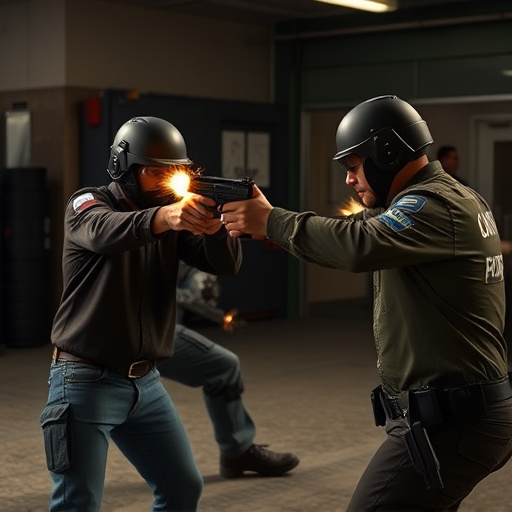Inflammatory agent personal protection sprays combat fires by reducing surface tension, attracting moisture, and suppressing combustion. The key deployment method, Spray and Move, involves quickly spraying the aerosolized solution towards the flame base while moving away to create a protective barrier. Regular training sessions refine this technique, ensuring safe and effective use in high-pressure situations. Safety protocols include understanding spray range, effectiveness, handling off-target effects, and post-application decontamination, with awareness of surroundings crucial to avoid complications.
Personal protection against inflammatory agents has become an essential consideration in today’s world. Inflammatory agent personal protection sprays offer a quick and effective defense mechanism, especially during emergency situations or when facing hazardous substances. This article delves into the crucial aspects of these protective sprays, including their ingredients, deployment techniques, and safety considerations. We explore how proper Spray and Move Deployment Techniques can enhance protection, ensuring individuals are prepared for unpredictable environments.
- Understanding Inflammatory Agent Personal Protection Spray: Ingredients and Their Role
- Effective Spray and Move Deployment Techniques for Optimal Protection
- Training and Safety Considerations for Responsible Use of Anti-Inflammatory Sprays
Understanding Inflammatory Agent Personal Protection Spray: Ingredients and Their Role
Inflammatory agent personal protection sprays are designed to neutralise and suppress incendiary devices, providing individuals with a crucial defense mechanism in potential high-risk situations. These sprays contain specific chemical compounds that play a vital role in their effectiveness. Key ingredients include surfactants, which reduce surface tension, enhancing the spray’s ability to coat and extinguish flames; humectants that attract and retain moisture, aiding in the cooling process; and various extinguishing agents like halon or synthetic foams, which directly combat the chemical reaction behind combustion.
The deployment techniques for these sprays are as important as their composition. Spray and move strategies involve quickly releasing the aerosolised solution towards the flame source, ensuring even distribution of the extinguishing chemicals. This method requires prompt action, as it disrupts the oxygen supply to the fire, suppressing its growth. Trained individuals learn to aim for the base of the flames and maintain a safe distance, maximising the spray’s reach and impact while minimising personal exposure to harmful byproducts.
Effective Spray and Move Deployment Techniques for Optimal Protection
When it comes to using a inflammatory agent personal protection spray, understanding the right deployment techniques is key to maximizing its effectiveness. A common and efficient method is the Spray and Move technique. This involves quickly spraying the agent in the direction of the approaching threat while simultaneously moving away. The key is to cover your escape route and surrounding areas with the spray, creating a protective barrier that obscures and disorientates the attacker.
For optimal protection, practice this movement in various scenarios to develop muscle memory. Aim for a distance of approximately 2-3 meters (6-10 feet) as you spray, ensuring thorough coverage. After deployment, continue moving at speed towards safety, allowing the spray to neutralize and contain the threat. Regular training sessions will refine your Spray and Move Deployment Techniques, ensuring swift and effective protection in high-pressure situations.
Training and Safety Considerations for Responsible Use of Anti-Inflammatory Sprays
Training and safety considerations are paramount when it comes to the responsible use of anti-inflammatory sprays, also known as personal protection sprays. Users must be adequately trained in both the mechanics of the spray and the appropriate response to its deployment. This includes understanding the range and effectiveness of the spray, as well as the specific targets for application. Training should cover different spray and move deployment techniques to ensure maximum safety and efficiency.
Safety protocols must include clear guidelines on how to handle potential off-target effects, accidental discharge, and post-application decontamination. Users need to be aware of their surroundings, including proximity to sensitive areas like eyes, open wounds, or flammable materials, as these can complicate the situation if exposed to the spray. Regular refresher courses are essential to maintain proficiency and stay updated on any changes in safety procedures related to anti-inflammatory sprays.
Inflammatory agent personal protection sprays are powerful tools, but their responsible use requires understanding key ingredients and optimal deployment techniques. By mastering Spray and Move Deployment Techniques, individuals can ensure maximum effectiveness in emergency situations. Training and safety considerations are paramount to foster a culture of responsible usage, empowering folks to protect themselves while minimising risks.
